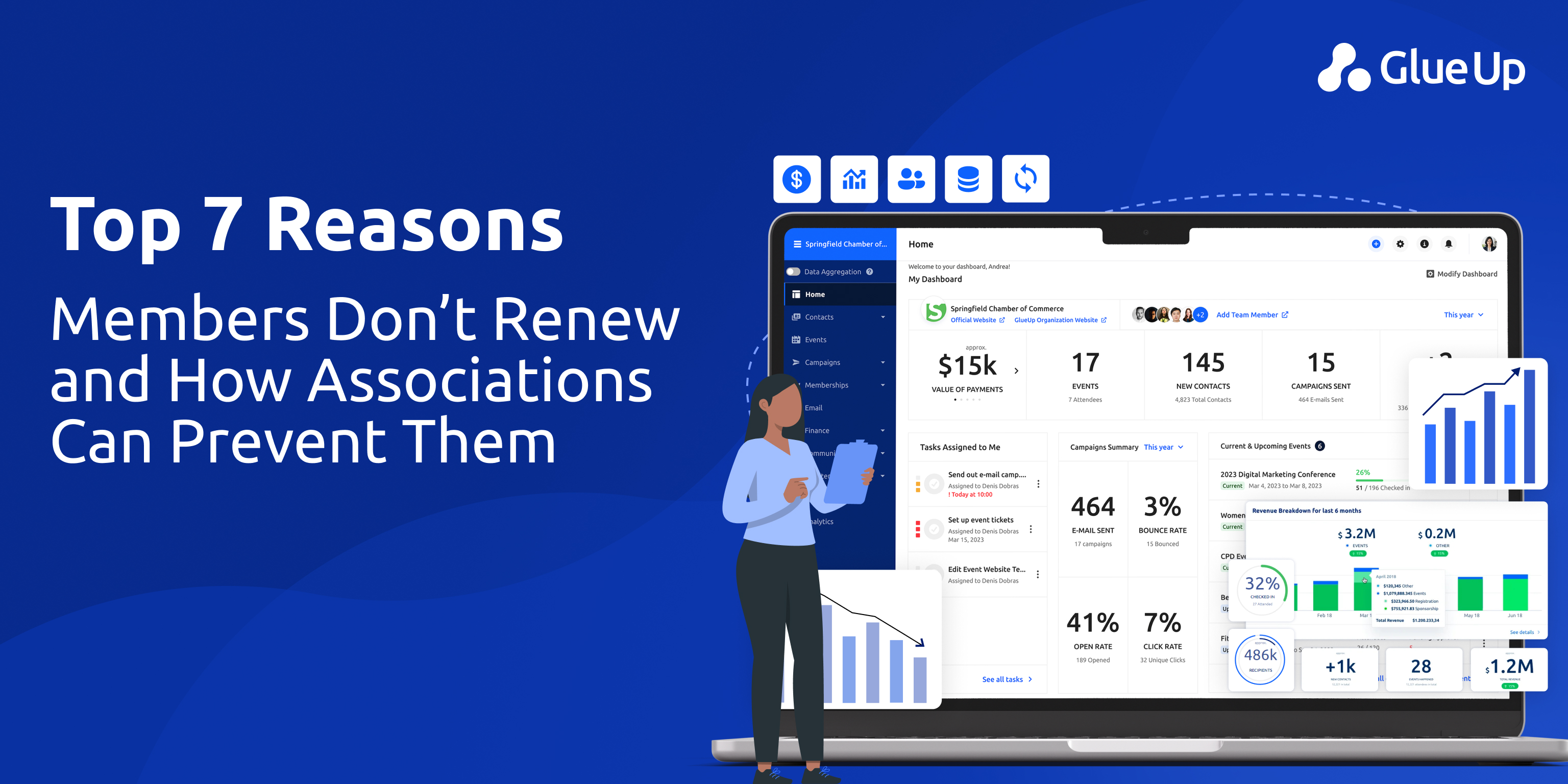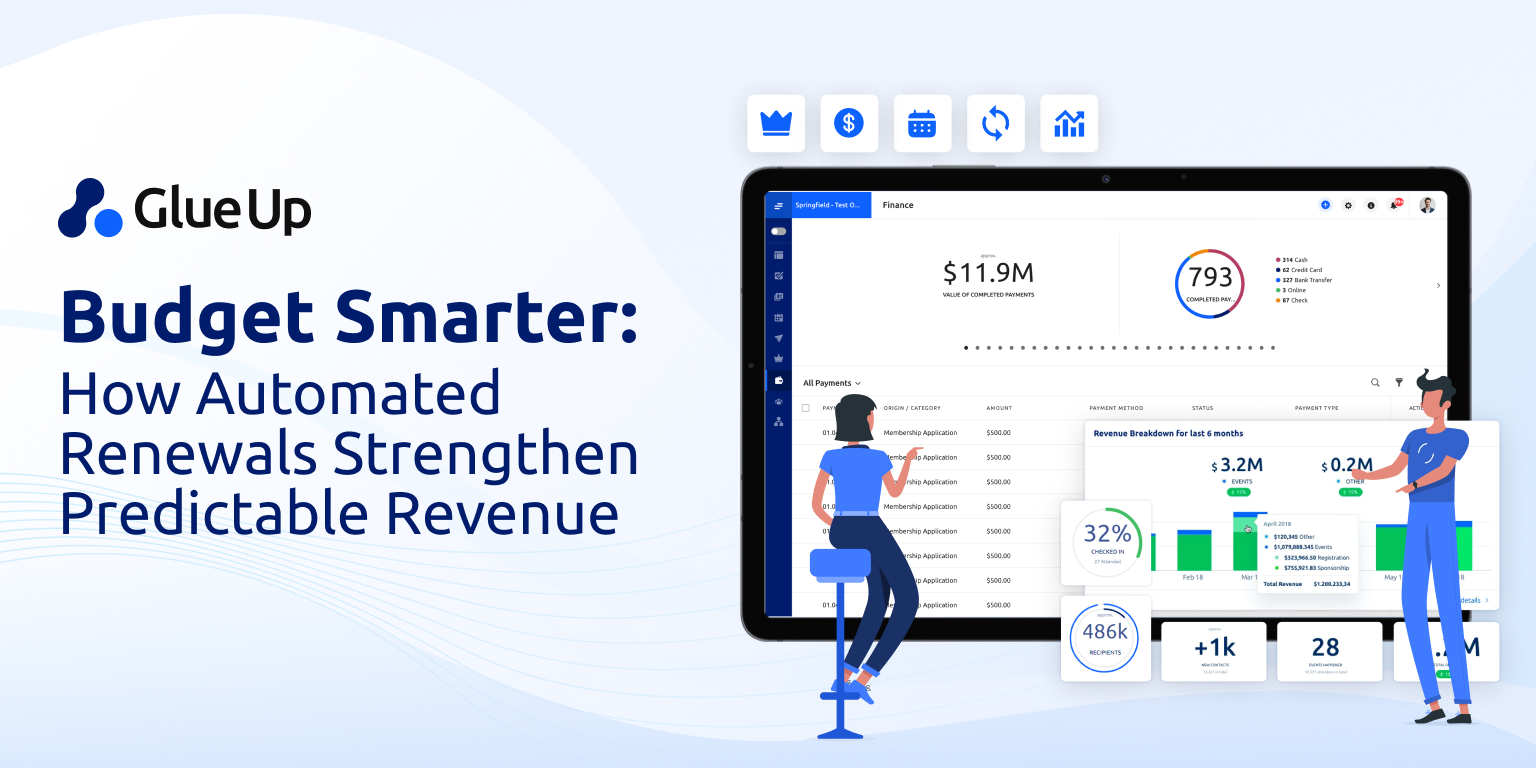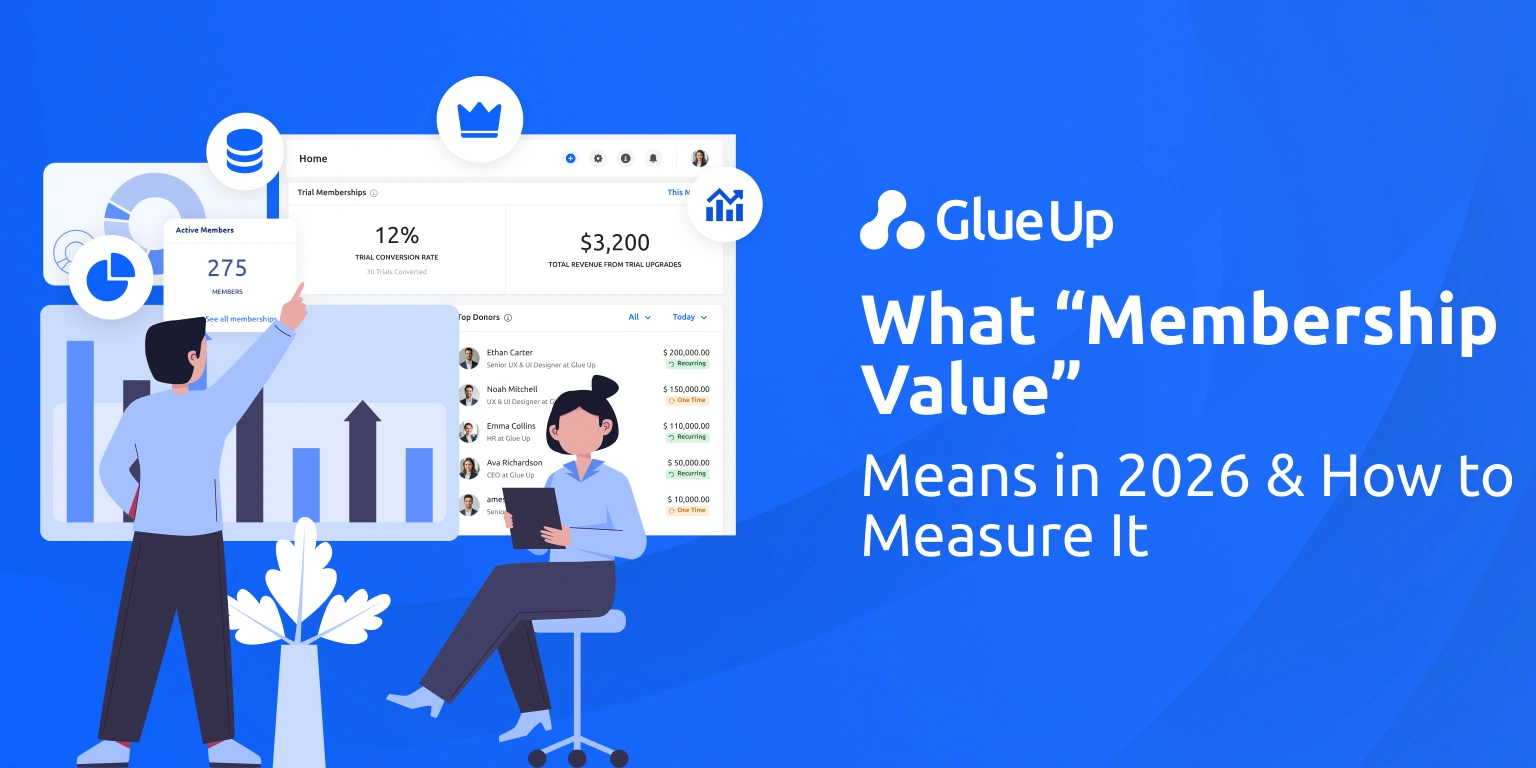
When you look at your renewal report next time, you might think: “Okay, these numbers are fine.” Member retention is a mirror. It mirrors whether your association is still meaningful, still helping, still aligning with members’ lives and careers. If members don’t renew, it’s rarely just about the dues. It’s about value, timing, fit, and connection.
For associations, chambers of commerce, and non-profits, retention matters more than acquisition. Because acquiring a new member cost more time, more effort, more outreach. But keeping a member is keeping a promise made at the moment they joined and keeping the relationship alive. And when you nail that, renewal becomes less of a negotiation and more of a given.
In this article, we’ll explore member retention deeply: what drives non-renewals, which fixes carry the highest ROI, how to design smart re-engagement systems, and how to set up pricing, payment, community, survey and renewal mechanics that support real retention. By the end, you’ll walk away with both big ideas and concrete next-week actions. Let’s dig in.
Key Takeaways
Member retention is more than renewals; it’s your association’s stability index. Renewal numbers reveal whether your programs, communications, and community still deliver real value. When members see clear outcomes, retention becomes the natural result, not the annual struggle.
Early engagement is the single strongest predictor of renewal. The first 90 days define the relationship. Members who complete small but meaningful actions, attending an event, joining a discussion, updating a profile, are exponentially more likely to renew the following year.
Most membership losses are operational. Billing friction, expired cards, or poor communication cause involuntary churn that has nothing to do with satisfaction. Implementing automatic renewal, smart retry logic, and multiple payment options can recover up to 40% of lost revenue.
Personalization drives retention ROI. Segmented communication and career-stage-aligned benefits outperform one-size-fits-all messaging. Associations that tailor outreach by role, interest, or engagement history consistently report higher renewal rates and stronger perceived value.
Retention is a culture built through systems. Sustainable member retention comes from integrated processes: data-driven onboarding, community follow-ups, lapsed-member surveys, and flexible pricing. Associations that treat retention as daily infrastructure, not an annual project, build lasting loyalty and predictable growth.
Quick Reads
Why Member Retention Matters Far Beyond the Renewal Invoice
Think for a moment about your dues revenue. Each renewal means less pressure on acquiring someone new, less strain on your marketing budget, less disruption in your community. According to recent association research, membership retention is foundational for organizational stability, growth, and influence.
Another dimension: when older members leave, your institutional knowledge, your network strength, your community bonds weaken. A study of communities found that turnover erodes social capital and reduces performance.
Then there’s the “first renewal” phenomenon: a membership expert noted that a new member’s first renewal is disproportionately valuable. If they get through year one, their likelihood of renewal in year two jumps significantly.
So, member retention is sustaining mission, preserving networks, enabling impact, and stabilizing revenue.
The Seven Hidden Reasons Members Don’t Renew, and How to Fix Them
Below are the seven most common underlying causes of renewal failure, shaped as a lifecycle story. For each: the reason, the deeper dynamic, and a fix your association can implement.
Reason 1: Value Proposition Blurred
At sign-up you told the member: here’s what you’ll get. But six months later, they can’t articulate what they got. The promise and the experience diverged. If value isn’t clear and reinforced, retention suffers. Research tells us associations must continually deliver meaningful value.
Fix: Re-map your member benefits to outcomes. For example: “Within six months you’ll gain 2 peer contacts, attend one advanced workshop, and have a published case snippet.” Then routinely send short “Here’s what you’ve accomplished” emails. Make value visible.
Reason 2: Onboarding Fails to Build Habits
The first 90 days after joining matter most. If a member doesn’t take meaningful action in that window, attend something, connect with a peer, complete a profile, their renewal probability drops significantly.
Fix: Design a 30-60-90-day path: week 1 fill your profile; week 2 join a small group; week 4 attend your first deep-dive event; week 8 share your first “win” with another member. Make the steps small, visible, and rewarding.
Reason 3: Communications Feel Generic or Mis-Timed
When your member sees generic “newsletter” after “newsletter” and little of it seems personally relevant, they feel like just a number. Engagement drops, and with it, renewal. The associations that segment, time messages, use behavior triggers, retain better.
Fix: Create audience segments by role, career stage, interest. For each group send a tailored monthly digest: highlight one event, one peer outcome, one quick action. Use trigger messaging: “You attended Event A, here’s your next step.”
Reason 4: Billing Friction and Payment Failure
Sometimes the reason is purely operational. Payment fails, card expires, the renewal email lands in spam, and the member drifts away. This kind of non-renewal is involuntary churn. In subscription businesses, up to 20-40 % of churn is involuntary.
Fix: Turn on automatic renewal, implement account-updater services, send pre-expiry alerts, allow flexible payments (monthly, quarterly, annual), support multiple payment rails. In other words: reduce the friction between intent to stay and action to pay.
Reason 5: Benefits Don’t Match Life Stage or Employer Priorities
A mid-career professional might join for leadership tracks; an early-career member might want job-board access; a senior executive might care about policy influence. If your benefits don’t map to these life stages, the member feels mis‐fit. Research shows associations that align offerings to career stage improve retention.
Fix: Develop a tiered benefit model. For early-career: mentoring, job tools, community picks. For mid-career: leadership programmes, board-prep, peer cohorts. For senior: thought-leadership access, policymaker briefings, ambassador roles. Communicate the fit clearly up‐front and during renewal.
Reason 6: Community Is Quiet, and Events Don’t Convert into Relationships
Your annual conference was great, but if after the event the member returns to a quiet inbox, the momentum fades. The strong associations turn events into ongoing community cycles. Studies of group dynamics show that commitment and retention are bolstered by recurrent social engagement.
Fix: After each event send a “next step” sequence: join a small peer circle (6-10 people), schedule a 15-minute follow-up call, start a topic thread in your digital community. Make the event the launchpad for ongoing connection.
Reason 7: You Didn’t Ask, and They Drifted Away
Sometimes the simplest reason: no one asked why they left. No win-back offer. No gentle nudge. Lapsed members often leave quietly, without engaging. The lack of “we miss you” means lost data, lost redemption.
Fix: Launch a lapsed-member survey (template below). Then run a win-back email sequence (see later section). Use the responses to tag non-renewals by cause (value gap, billing issue, job change, benefits misfit) and build a dashboard.
High-ROI Tactics Associations Can Deploy Now
Let’s move from causes to high-leverage tactics, those that give the biggest return for effort and cost.
Automatic Renewal + Decline Management
This is foundational. In subscription models, failure to collect from willing members, or letting billing decline slip, can erode revenue fast. Some studies find up to 1-4 % of churn every month is due to payment issues.
Implementation Checklist
Enable auto-renew for dues and ancillary programmes.
Integrate account-updater services to handle expiring cards.
Pre-expiry alerts at 30 and 7 days.
Smart retry logic for soft declines (e.g., request funds again after 48 hrs).
Provide monthly/quarterly payment options to align with employer budgeting.
Track decline reasons and create a dashboard: decline rate, recovery rate, days to recover.
Segmented, Personalized Communications
Generic outreach doesn’t build loyalty. Personalized, behavior-based communication does. Segment by career stage, role, event history, community participation.
Implementation Checklist
Build at least 3 segments initially: Early-Career Mid-Career Senior/Leader.
Create an “Engagement Digest” for each segment: peer story, upcoming event, quick action.
Trigger welcome sequence: “Joined? Here’s your first 30-day action.”
Trigger inactivity sequence: “You haven’t logged in for 45 days, here’s what’s happening.”
Use preference center: let members choose how they want communications (email, mobile app, SMS, postal).
Career-Stage Benefit Design
Align your offering architecture to member life-stage. This increases relevance and connection.
Implementation Checklist
Map your member base: what career or employer type they are.
For each stage define 3 key outcomes (job/role, network, thought leadership).
Align benefits to those outcomes and label clearly (for example: “Launch & Learn”, “Lead & Grow”, “Influence & Impact”).
Include employer value messaging: how this membership helps your employer succeed (especially useful for members paid by employer).
Event-To-Community Conversion Loop
Events are expensive; return depends on extending engagement beyond the two-day conference.
Implementation Checklist
At an event, assign small breakout groups of 6–10 with a facilitator.
At event close, prompt each group to schedule a virtual follow-up.
In your digital community platform, create a dedicated thread per breakout group, encouraged to log one insight/member contact within 7 days.
Post-event: send an “Action Pack” email with 3 one-minute next steps.
Measure: percentage of event attendees who engage in the community within 30 days.
Onboarding Pathway for the First 90 Days
Retention starts at day one.
Implementation Checklist
Create a 30-60-90-day onboarding plan.
Within the first week: welcome call or video, profile completion, buddy/mentor pairing.
Month one: invite to small event or group meet.
Month two: goal-setting email – ask “What will membership help you achieve this year?”
Month three: milestone email – “You’ve done X, now choose your next step.”
Track: % of new members completing each phase. Use non-completion as an early warning.
How to Measure What Matters for Member Retention
You can’t improve what you don’t measure. Here are the metrics that matter, and accessible formulas you can use.
Member retention rate = (Number of members at end of period − new members acquired during period) ÷ Number of members at start of period.
Member churn rate = Members lost during period ÷ Number of members at start of period.
Activation rate (first 90 days) = New members who complete a defined set of actions (e.g., profile + event + community post) ÷ New members.
Decline recovery rate = Number of members regained via automatic/alert billing efforts ÷ Number of payment declines.
Lifetime value of a member = Average dues × (1 / churn rate) (makes a simplification).
Event-to-community conversion rate = Event attendees who join a community group within 30 days ÷ Total event attendees.
Set monthly dashboards for: renewal probability by cohort, first-90-day activation, decline recovery days, and win-back reconversion. According to industry commentary, members who don’t engage in the first 90 days have approximately 73% higher churn risk.
A Ready-To-Use Lapsed-Member Survey Template
Here’s a short survey you can deploy within a week. It’s designed to identify root causes of non-renewal, surface actionable signals, and feed into segmentation.
What primary outcome did you hope to achieve from your membership this year? (Pick one)
Which benefit did you feel helped you the least? (Pick one + free text)
How many events did you attend in the last 12 months?
Did you engage in the online community at least once a month? (Yes/No)
What prevented you from engaging? (Time/workload, relevance, price, employer changed, payment/billing issue, other)
Did membership help you reach a specific win (promotion, client, partnership, grant)? (Yes/No)
If yes – what was it? (Free text)
If no – what would have changed that? (Free text)
Was the renewal process easy? (Yes/No)
Would you have preferred a payment plan or different renewal timing? (Monthly, Quarterly, Annual, Employer pays)
Would you consider returning with a 90-day “try-again” plan? (Yes/No)
If yes – which two benefits, should we prioritize for you? (Pick two)
Use responses to classify non-renewals into: Value gap, Onboarding gap, Engagement gap, Billing friction, Life/Employer change. Track causes by cohort and employer size.
Tiered Pricing & Flexible Payment Plans: Aligning Fit and Finances
When people talk about dues, it often feels like a uniform number. But retention thrives when pricing feels fair, flexible, and aligned.
Design Principles
Price tiers should reflect outcomes. Label them by stage (e.g., “Emerging Professional”, “Established Leader”, “Executive Influencer”).
Offer payment flexibility: monthly, quarterly, annual. Let the employer choose invoicing and PO workflows.
International members: support local payment rails (ACH, SEPA), avoid high card-failure risks.
Provide “employer pack” pricing: one invoice covers an individual + their team, with a communications toolkit for the employer to show value back.
Review renewal discounts: e.g., 5 % for multi-year, or “bring a peer” referral credit.
These pricing and payment mechanisms reduce friction and make renewal less of a hurdle. And as the payments research shows, when you reduce billing friction you directly improve retention.
Your Next-Week Action Plan
Here’s what you and your team can start doing immediately to improve member retention:
Draft one sentence value-outcome statement for each benefit in your membership offer – publish it in your welcome email.
Enable at least one payment alert: “Your card will expire in 30 days – update now”.
Send to your data team: “List of members who joined in the past 90 days and have zero event or community activity” → assign them to a welcome-call queue.
Deploy the lapsed-member survey to all non-renewals in the last 12 months. Sort responses by cause.
Audit your tier/pricing structure: Does each tier clearly map to an outcome? Is there a monthly/quarterly plan? Are employer-pay options articulated?
Completion of these steps creates early momentum, gives you tangible signals to track, and sets you up for deeper work.
Making Retention Part of Your Culture
Member retention isn’t a single marketing campaign or one-off special offer. It’s a culture. It’s built when your association continually shows up, aligns with members’ changing lives, simplifies their access, and ensures they feel part of something lasting.
Retention begins on day one. It grows in the 90 days after join; it lives in community, in meaningful benefits, in clean billing processes, in communication that feels personal. The associations that treat renewal as an afterthought will see the cracks in their membership base. The ones that treat retention as a strategic pillar will build loyalty, advocacy, stable revenue, and field impact.
At Glue Up, we believe member retention is the engine behind thriving communities. With the right data, tools, and mindset, your association can stop watching members walk away, and instead build a base that stays, grows, and advocates.
Your next renewal cycle is the moment to prove that membership meant something. Let’s make it count.



